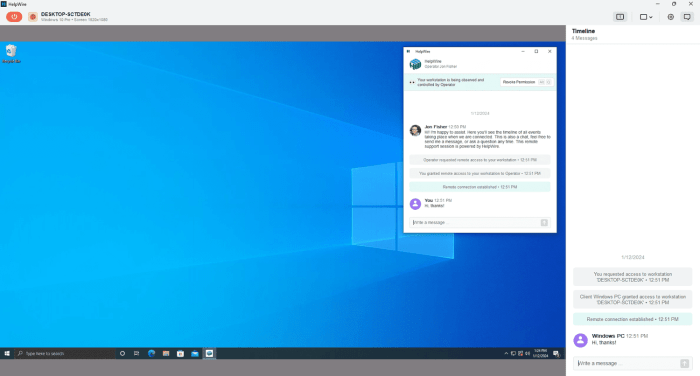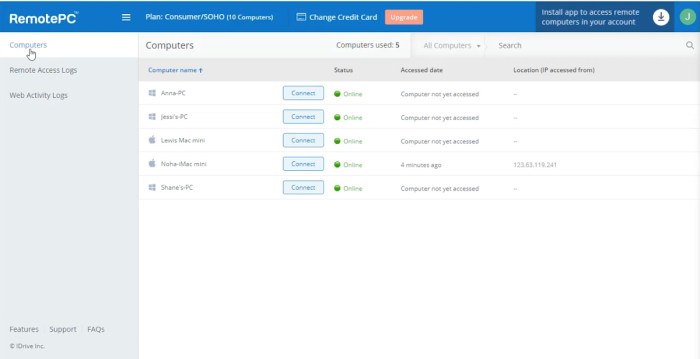Help desk remote access software empowers IT support teams to troubleshoot and resolve issues efficiently, regardless of location. This powerful tool facilitates seamless remote assistance, improving response times and customer satisfaction. It’s a crucial element in today’s distributed work environments.

Source: lifewire.com
By providing secure and reliable remote connectivity, help desk remote access software allows technicians to diagnose problems quickly and implement solutions effectively. This translates to increased productivity and reduced downtime for users. The right software can significantly enhance the efficiency of your entire help desk operation.
Remote access software is a critical tool for help desks, enabling technicians to diagnose and resolve issues remotely. This detailed guide explores the features, benefits, and considerations for choosing the right remote access software for your help desk. We’ll cover various types of remote access software, security best practices, and common use cases.
Understanding Remote Access Software for Help Desks
Remote access software allows technicians to connect to users’ computers or devices remotely. This is invaluable for troubleshooting software problems, fixing hardware issues, and providing support without the need for physical presence. Remote support is particularly crucial for businesses with geographically dispersed teams or clients. Key features often include real-time screen sharing, file transfer, and control of the remote device.
Types of Remote Access Software, Help desk remote access software
Several types of remote access software cater to different needs. Some popular options include:
- Desktop Sharing Software: These solutions focus on sharing the user’s desktop, enabling technicians to see and interact with the user’s environment in real-time. Examples include TeamViewer, AnyDesk, and Splashtop.
- Remote Control Software: This type of software allows technicians to take complete control of the user’s computer, enabling them to run applications and make system-level changes. It’s more powerful than desktop sharing, but requires more caution due to increased access.
- VPN-based Remote Access: Virtual Private Networks (VPNs) provide secure encrypted connections for remote access. They’re often used for accessing corporate resources remotely and are beneficial for help desks managing sensitive data.
Benefits of Remote Access Software for Help Desks
Implementing remote access software brings several key advantages:
- Increased Efficiency: Technicians can resolve issues faster without needing to travel to the user’s location.
- Reduced Costs: Minimizes travel expenses and downtime for users.
- Improved User Satisfaction: Faster issue resolution and reduced wait times contribute to happier customers.
- Enhanced Security: Modern remote access software often includes strong encryption and authentication protocols to protect sensitive data.
- Scalability: Remote access solutions can adapt to increasing help desk workloads and support more users as the business grows.
Choosing the Right Remote Access Software
Factors to consider when selecting remote access software include:
- Security Features: Strong encryption, multi-factor authentication, and access controls are essential.
- Ease of Use: Both technicians and users should find the software intuitive and easy to navigate.
- Cost: Consider the licensing model and pricing structure for your team size.
- Scalability: Ensure the software can handle the expected growth of your help desk operations.
- Technical Support: Reliable support is crucial when issues arise.
Security Best Practices for Remote Access
Implementing robust security measures is paramount:
- Strong Passwords: Use strong, unique passwords for all accounts.
- Two-Factor Authentication: Enable this extra layer of security whenever possible.
- Regular Software Updates: Keep the software updated to patch vulnerabilities.
- Firewall Protection: Ensure a robust firewall is in place.
- Data Encryption: Use encryption to protect sensitive data during transmission.
Common Use Cases for Help Desk Remote Access
Remote access software is applicable across a range of help desk scenarios:
- Troubleshooting software issues
- Fixing hardware problems
- Providing remote training
- Setting up new devices
- Managing user accounts
FAQ
Here are some frequently asked questions about remote access software for help desks:

Source: comparecamp.com
- Q: What are the most popular remote access software options?
- A: TeamViewer, AnyDesk, Splashtop, and LogMeIn are among the leading choices.
- Q: How secure is remote access software?
- A: Modern remote access software employs robust security protocols, but best practices like strong passwords and two-factor authentication are crucial.
- Q: What are the potential drawbacks of remote access?
- A: Potential security risks and the need for careful user training.
- Q: What are the technical requirements for remote access?
- A: A stable internet connection and compatible devices are needed.
References:
Conclusion: Help Desk Remote Access Software
Remote access software is a powerful tool for modern help desks, enabling efficient, cost-effective, and secure remote support. Choosing the right software, implementing strong security measures, and training your team are key to maximizing its benefits.
Call to Action: Ready to streamline your help desk operations? Explore our recommended remote access software solutions today. Click here to learn more and request a demo.
In conclusion, help desk remote access software is an indispensable asset for modern IT support. Its ability to streamline remote assistance, enhance efficiency, and improve user satisfaction makes it a valuable investment for any organization. By leveraging this technology, businesses can effectively manage and resolve technical issues, ensuring smooth operations and a positive user experience.
FAQs
What security measures are in place for remote access?
Robust security protocols, such as encryption and multi-factor authentication, are standard features. These safeguards protect sensitive data and ensure secure remote connections.
Can this software be used across different operating systems?
Compatibility with various operating systems (Windows, macOS, Linux) is crucial for widespread use. Look for software that provides seamless support across these platforms.
What are the typical costs associated with implementing this software?
Pricing structures vary based on features, user licenses, and support options. Consider factors like the number of users, required features, and the level of ongoing support when evaluating pricing.
How does this software integrate with existing help desk systems?
Many remote access solutions integrate seamlessly with popular help desk platforms. Compatibility with your existing infrastructure is vital for a smooth transition.